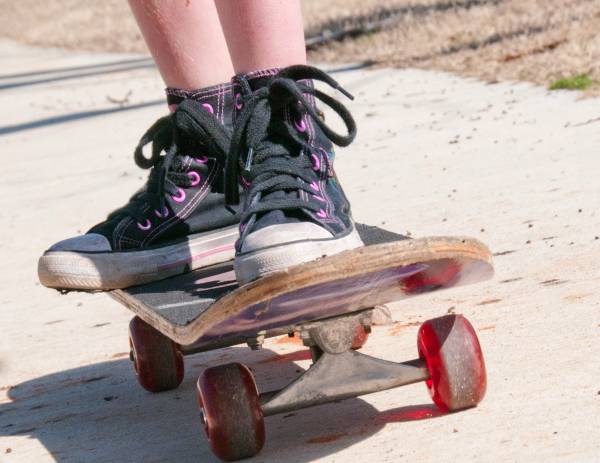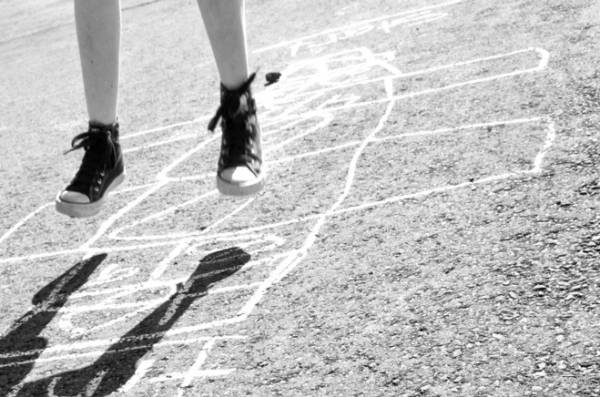High-tops were originally intended for basketball players to help prevent injuries from sudden stops and quick turns. But the high-top shoe has become popular and fashionable in mainstream society, especially with kids.
But is this a problem beyond just your wallet? I contend that there are detrimental effects of wearing high-top shoes for fashion purposes, rather than for athletic purposes. If your child is wearing these shoes, you need to be aware of the numerous injuries that are possible just from walking around in these things.
The Origin of High-Tops
Matt Powell, a senior analyst for Sports One Source, a market research firm, reported the average consumer’s decision to buy a shoe is based eighty percent on fashion and twenty percent on a professional sport player endorsing the shoe. He further stated that 85% of performance footwear is never worn for its intended purpose.
Enter the high-top shoe.
There is plenty of debate over the merits of high-top shoes versus low-top shoes for basketball players. In a 1993 study conducted by the University of Oklahoma, which appeared in the American Journal of Sports Medicine, no correlation was found between wearing high-tops and increasing or decreasing ankle injuries.
FREE THE FEET: Katy Bowman – The Biomechanics of Human Growth: Barefoot Babies
Yet other studies have found that increased ankle support during sports can reduce the likelihood of injuries. So, if evidence and research appear to be inconclusive or at least contradictory, what is the true debate?
High-Top Versus Low-Top Shoes
Advocates of high-top shoes for basketball players contend the extra support that surrounds the ankle (including the rear material of the shoe extending over the ankle bone) and the extra lacing to help keep the ankle joint stable are valuable in preventing injuries for players. They further assert that without the extra support of high-top shoes on the court, the ankle is left vulnerable to injuries ranging from breaks and sprains to soft tissue damage.
“If high-top shoes are meant to lend support to ankles in sudden stops and quick turns, as in a basketball setting, and youth in society are wearing these shoes without these athletic stresses placed on the ankle, then our kids are wearing the wrong shoe for everyday function.”
Advocates of low-top shoes contend that because these shoes do not have the extra material, they are much lighter than high-tops, helping improve speed and agility on the court, as well as increasing full range of motion. In an interview with LiveStrong, Danny McLarty of Flex Personal Training stated that low-top shoes actually serve to strengthen ankles, forcing the muscles to stabilize the ankle joint without any external supports (as in braces, taping, or shoe material).

Kids and High-Tops
If high-top shoes are meant to lend support to ankles in sudden stops and quick turns, as in a basketball setting, and youth in society are wearing these shoes without these athletic stresses placed on the ankle, then our kids are wearing the wrong shoe for everyday function. This leads to problems. Many problems.
With high-top shoes becoming an everyday shoe for youth, there is a significant decrease in their ankle function. Because the lacing and extra material of these shoes act as a brace, the ankle suffers from a decrease in flexibility and strength.
“In a 1993 study conducted by the University of Oklahoma, which appeared in the American Journal of Sports Medicine, no correlation was found between wearing high-tops and increasing or decreasing ankle injuries.”
Martin Kuban – personal trainer, author, and founder of Fix Knee Pain – agrees that high-tops restrict mobility. He asserts that if a joint intended for mobility becomes less mobile, a stable joint directly above the less mobile joint picks up the slack with increased mobility and, subsequently, less stability. Simply put, if you lack ankle mobility, then you automatically have a higher susceptibility to knee pain.
If the ankle joint, tendons, ligaments, and muscles are not actively worked in their intended full range of motion, then mobility is greatly decreased. As mobility is decreased, so is performance in all activities, including everyday functions such as walking, as well as sports performance. Because the range of motion in the ankle is greatly decreased, surrounding tendons, ligaments, and muscles cannot be properly strengthened, leading to “weak ankles.”
Koban further asserts the every day wearing of high-top shoes can create a vicious cycle of problems:
- Ankle and knee pain
- Decreased range of motion in the ankle joint and surrounding tendons, ligaments, and muscles
- Increased chance of ankle fractures, as well as injuries to tendons, ligaments, and muscles.
- Ankle injuries lead back to bracing the weakened ankle, starting the cycle again
Vito Di Cosola, a strength and conditioning coach and nutrition advisor for high school, college, and NCAA basketball players, maintains that low-top shoes actually serve to strengthen ankles, forcing the muscles to stabilize the ankle joint on their own without any exterior support. He further advocates the use of low-top shoes and offers that people actually want and need less ankle support in every day shoes, as well as in sports performance shoes. He encourages people to buy and wear shoes that give good motion control and stability at the heel, as much as possible.
His final position on high-tops? “Get out of those high-top shoes as much as possible, keep your dorsiflexion range of motion, and strengthen those ankles!”

Is It Worth the Risk?
While high-top shoes have become popular in mainstream society, they have also contributed to a generation’s ankle and knee problems. As stated earlier, the original intent of the high-top was to help prevent ankle injuries to basketball players. It was never intended to be used as an everyday shoe. Although many other sports have introduced a performance high-top, such as high-top cleats, the intent of the high-top is the same – to help prevent ankle injuries.
“Because the range of motion in the ankle is greatly decreased, surrounding tendons, ligaments, and muscles cannot be properly strengthened, leading to ‘weak ankles.'”
Because high-top shoes are now used as a fashionable alternative to regular shoes and sneakers, high-tops have stopped performing their primary function of protecting an athlete’s ankles and have now become an aesthetic choice.
Unfortunately, this fashion statement comes at a price – knee pain, restricted mobility in the ankle, weakened ankles, tendons, ligaments, and muscles in the surrounding area, decreased range of motion, and an increased chance of injury to the ankle.
Now that you know this, are you ready to rethink the fashionable high-top shoes trend for your child?
References
1. Di Cosola, Vito. “Do High Top Shoes Prevent Sprained Ankles?” March 27, 2014. Accessed 14 Nov 2014.
2. Dres, Wayne. “Kobe’s feet to feature new low-top shoe”. Dec 11, 2008. Accessed 14 Nov 2014.
3. Koban, Martin. “Why your High Top Shoes cause knee pain, Accessed 16 Nov 2014.
4. Lynch, William. “Why Wear Hightops in Basketball?”. March 13, 2014, Accessed 14 Nov 2014.
Photos courtesy of Shutterstock.






